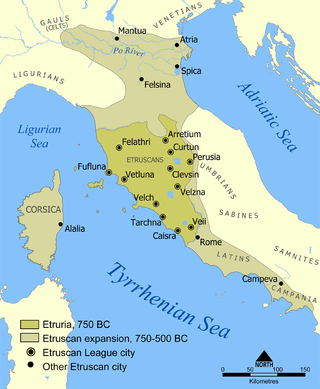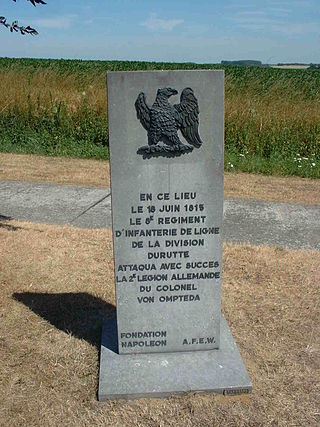History and description
The stele is a notable artefact, datable to c.550 BC and discovered in two fragments. It shows a warrior in relief within a border with an inscription (which says "I belong to Avile Tites, ...uchsie donated me" TLE2 386), typical of central northern Etruria, with Greco-oriental influences.
The warrior, to whom the stele was dedicated as a tombstone, is represented in profile in full armour, facing left, with his legs split as if he was in motion. He wears a short tunica, a cuirass (lorica), shoulder armour, and greaves on his shins and is armed with a lance and a dagger with a curved hilt. His body is depicted in profile, like his face, which has a pointy beard, layered hair, elongated eyes and lips bent in a smile.
The style of the stela is influenced by a taste for full, monumental forms, typical of the late Ionic style. The hairstyle, of the"Daedalic" type, demonstrates the provincial scope of the warrior, on account of a use which must now be dated to the period.

The Etruscan civilization was an ancient civilization created by the Etruscans, a people who inhabited Etruria in ancient Italy, with a common language and culture who formed a federation of city-states. After conquering adjacent lands, its territory covered, at its greatest extent, roughly what is now Tuscany, western Umbria, and northern Lazio, as well as what are now the Po Valley, Emilia-Romagna, south-eastern Lombardy, southern Veneto, and western Campania.

Etruria was a region of Central Italy delimited by the rivers Arno and Tiber, an area that covered what is now most of Tuscany, northern Lazio, and north-western Umbria. It was inhabited by the Etruscans, an ancient civilization that flourished in the area from around the 8th century BC until they were assimilated into the Roman Republic in the 4th century BC.

Plate armour is a historical type of personal body armour made from bronze, iron, or steel plates, culminating in the iconic suit of armour entirely encasing the wearer. Full plate steel armour developed in Europe during the Late Middle Ages, especially in the context of the Hundred Years' War, from the coat of plates worn over mail suits during the 14th century, a century famous for the Transitional armour, in that plate gradually replaced chain mail.

A stele, from Greek στήλη, stēlē, plural στήλαι stēlai, is a stone or wooden slab, generally taller than it is wide, erected in the ancient world as a monument. The surface of the stele often has text, ornamentation, or both. These may be inscribed, carved in relief, or painted.

The talwar, also spelled talwaar and tulwar, is a type of curved sword or sabre from the Indian subcontinent.

Red-figure pottery is a style of ancient Greek pottery in which the background of the pottery is painted black while the figures and details are left in the natural red or orange color of the clay.

Scale armour is an early form of armour consisting of many individual small armour scales (plates) of various shapes attached to each other and to a backing of cloth or leather in overlapping rows. Scale armour was worn by warriors of many different cultures as well as their horses. The material used to make the scales varied and included bronze, iron, steel, rawhide, leather, cuir bouilli, seeds, horn, or pangolin scales. The variations are primarily the result of material availability.

Lullubi,Lulubi, more commonly known as Lullu, were a group of Bronze Age tribes during the 3rd millennium BC, from a region known as Lulubum, now the Sharazor plain of the Zagros Mountains of modern-day Sulaymaniyah Governorate, Iraq. Lullubi was neighbour and sometimes ally with the Hurrian Simurrum kingdom. Frayne (1990) identified their city Lulubuna or Luluban with the region's modern town of Halabja.

Pyrgi was originally an ancient Etruscan town and port in Latium, central Italy, to the north-west of Caere. Its location is now occupied by the borough of Santa Severa. It is notable for the discovery here of the gold tablets, an exceptional epigraphic document with rare texts in Phoenician and Etruscan languages, and also the exceptional terracotta pediment statues from the temple.

Xtampak is a Maya archaeological site in the Mexican state of Campeche. A major town in the Chenes region, it flourished during the Late Classic era.

Etruscan art was produced by the Etruscan civilization in central Italy between the 10th and 1st centuries BC. From around 750 BC it was heavily influenced by Greek art, which was imported by the Etruscans, but always retained distinct characteristics. Particularly strong in this tradition were figurative sculpture in terracotta, wall-painting and metalworking especially in bronze. Jewellery and engraved gems of high quality were produced.

Béla Iványi-Grünwald was a Hungarian painter, a leading member of the Nagybánya artists' colony and founder of the Kecskemét artists' colony.

A Daunian stele is a type of stone funerary monument constructed by the Daunians, an Iapygian tribe which inhabited Apulia in classical antiquity. Daunian stelae were made from the end of the 8th century BC to the 6th century BC. They consist of a parallelepiped-shaped plate with a protrusion on the upper side and decoration on all four sides. Sizes vary between 40 and 130 cm in height, and consequently, between 20 and 80 cm in width while the thickness is between 3 and 12 cm.
Poggio Colla is an Etruscan archaeological site located near the town of Vicchio in Tuscany, Italy.

Etruscan architecture was created between about 900 BC and 27 BC, when the expanding civilization of ancient Rome finally absorbed Etruscan civilization. The Etruscans were considerable builders in stone, wood and other materials of temples, houses, tombs and city walls, as well as bridges and roads. The only structures remaining in quantity in anything like their original condition are tombs and walls, but through archaeology and other sources we have a good deal of information on what once existed.

The Old General Staff Building, also known as the Stone Palace and the Baumgarten Palace, houses the Ministry of Defence of Serbia. It is located in Savski Venac, Belgrade.
P. Gregory Warden is an American archaeologist, former President and Professor of archaeology at Franklin University Switzerland, and expert on Etruscan art, archaeology, and ritual, Roman architecture and Greek archaeology. He is the inaugural Mark A. Roglán Director of the Custard Institute for Spanish Art and Culture at Southern Methodist University.

The Stele of Arniadas is an Archaic-period funerary stele in Corfu, Greece, found on the tomb of Arniadas, a warrior. It was intended to mark his grave and honour his memory by enumerating his bravery in a battle near the river Arachthos in the location of ancient Amvrakia, modern-day Arta. The stele was found in 1846 at the necropolis of the Corfu Palaiopolis in the suburb of Garitsa, near the Tomb of Menecrates, after a demolition of Venetian fortifications in the area by the British, who at the time ruled Corfu. The date of the stele is early 6th century BC.

Augustan and Julio-Claudian art is the artistic production that took place in the Roman Empire under the reign of Augustus and the Julio-Claudian dynasty, lasting from 44 BC to 69 AD. At that time Roman art developed towards a serene "neoclassicism", which reflected the political aims of Augustus and the Pax Romana, aimed at building a solid and idealized image of the empire.

The Grave Stele of Pollis is a gravestone of the warrior Pollis, who fought and was killed in action during the Greco-Persian Wars. Since 1990, it has been a part of the permanent collection of the Getty Villa, and dating to 480 BC, presents the transition between Archaic Greek Sculpture to Classical Greek sculpture.

















